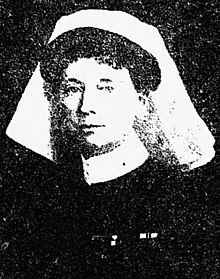Ethel Becher
Ethel Becher | |
|---|---|
 Becher in 1919 | |
| Born | 1867 |
| Died | 10 May 1948 (aged 80–81) |
| Allegiance | United Kingdom |
| Service | British Army |
| Years of service | 1899–1919 |
| Rank | Matron-in-Chief |
| Commands | Queen Alexandra's Royal Army Nursing Corps (1910–19) |
| Battles / wars | Second Boer War First World War |
| Awards | Dame Grand Cross of the Order of the British Empire Royal Red Cross & Bar Lady of Grace of the Order of Saint John |
Dame Ethel Hope Becher, GBE, RRC & Bar (1867 – 10 May 1948) was a British nurse who served in the War Office as matron-in-chief of the Queen Alexandra's Royal Army Nursing Corps from 1910 to 1919.
Early life
[edit]Ethel Hope Becher was born in 1867.[1][2] Her father was Arthur W. Becher, a colonel in the Bengal Staff Corps.[1][3] She attended private school and trained as a nurse at the London Hospital from 1893 to 1899 under Eva Luckes.[1][4]
Career
[edit]In 1899, she became a nursing sister and acting matron during the Second Boer War, and was awarded the Royal Red Cross for her work.[5] Becher was one of a group of six nurses from The London Hospital who were specially selected by Eva Luckes and Sydney Holland at Princess Alexandra's request to go out and nurse diseased and injured troops in South Africa.[4]
In 1903, Becher was appointed as principal matron of the Queen Alexandra's Imperial Military Nursing Service (later the Queen Alexandra's Royal Army Nursing Corps, the nursing branch of the British Army, which had been established by royal warrant just one year prior.[5][6] She was promoted to matron-in-chief in 1910, succeeding Caroline Keer in the role, and was stationed at the War Office.[5][7]
As matron-in-chief, she was responsible for the recruiting and administration of the entire nursing service, and oversaw nurses stationed in many regions, including Macedonia, Malta, Gibraltar, and France.[6] Becher almost retired at the start of the First World War in 1914, but decided to stay on.
Service during World War I
[edit]She supervised over 10,000 nurses and 9,500 members of the Voluntary Aid Detachment from 1914 to 1918.[1] She was named a Lady of Grace of the Order of Saint John in 1917, and was awarded a Bar to her Royal Red Cross in January 1918, becoming the first person to receive the award twice. She was appointed a Dame Grand Cross of the Order of the British Empire in June 1918.[5]
After the end of the war, Becher resigned her position as matron-in-chief in March 1919.[5] The media described her as a "modern Florence Nightingale" and wrote that it "would be hard to name any one woman whose part in the great war was more extraordinary".[5]
In 1931, Becher founded the United Services Nursing Club, which organised the provision of government grants to nurses who had served in the First World War.[8]
Ethel Becher died on 10 May 1948.[1]
References
[edit]- ^ a b c d e "Dame Ethel Hope Becher". The Times. 13 May 1948. Retrieved 8 April 2021.
- ^ Shields, Rosemary; Shields, Linda (2014). "Dame Maud McCarthy (1859–1949): Matron-in-Chief, British Expeditionary Forces France and Flanders, First World War". Journal of Medical Biography. 24 (4): 507–514. doi:10.1177/0967772013480610. PMID 25697351. S2CID 30901948. Retrieved 8 April 2021.
- ^ "The Drawing Room". The Times. 5 March 1891. Retrieved 8 April 2021.
- ^ a b Rogers, Sarah (2022). 'A Maker of Matrons’? A study of Eva Lückes’s influence on a generation of nurse leaders:1880–1919' (Unpublished PhD thesis, University of Huddersfield, April 2022)
- ^ a b c d e f "Modern Florence Nightingale To Resign, Now War Is Ended". The Atlanta Constitution. 23 March 1919. ProQuest 497611336. Retrieved 8 April 2021.
- ^ a b Cowper, Julia M (1 August 1960). "Nursing Services of the Army". Journal of the Royal United Service Institution. 105 (619): 412–418. doi:10.1080/03071846009421129. Retrieved 8 April 2021.
- ^ "Command & Control of Army Nurses". British Army Nurses. Queen Alexandra's Royal Army Nursing Corps. Retrieved 8 April 2021.
- ^ Asquith, Cynthia (28 April 1939). "Duchess Took Active Interest In Promoting Child Welfare". The Washington Post. p. 35. ProQuest 151214556. Retrieved 8 April 2021.
- 1867 births
- 1948 deaths
- British people of World War I
- British women in World War I
- British women nurses
- Dames Grand Cross of the Order of the British Empire
- English nurses
- Female nurses in World War I
- Ladies of Grace of the Order of St John
- Members of the Royal Red Cross
- People of the Second Boer War
- Queen Alexandra's Royal Army Nursing Corps officers
- World War I nurses
